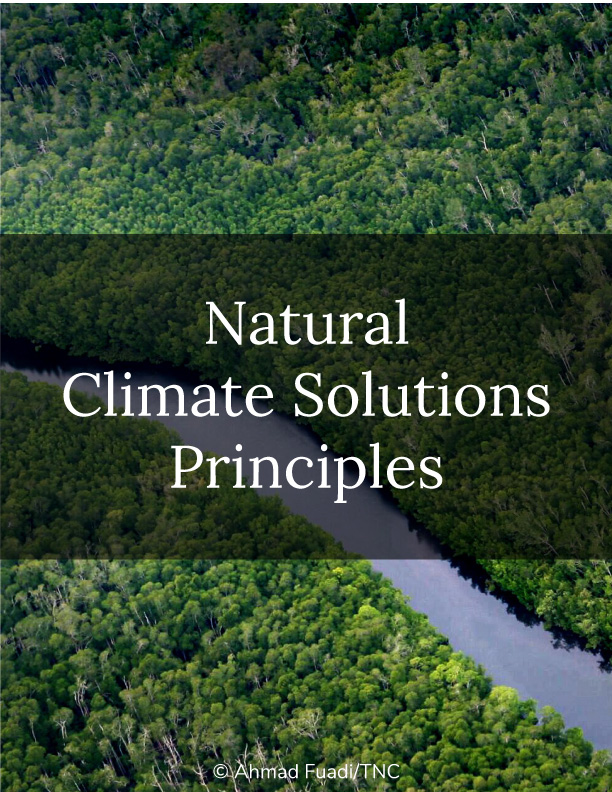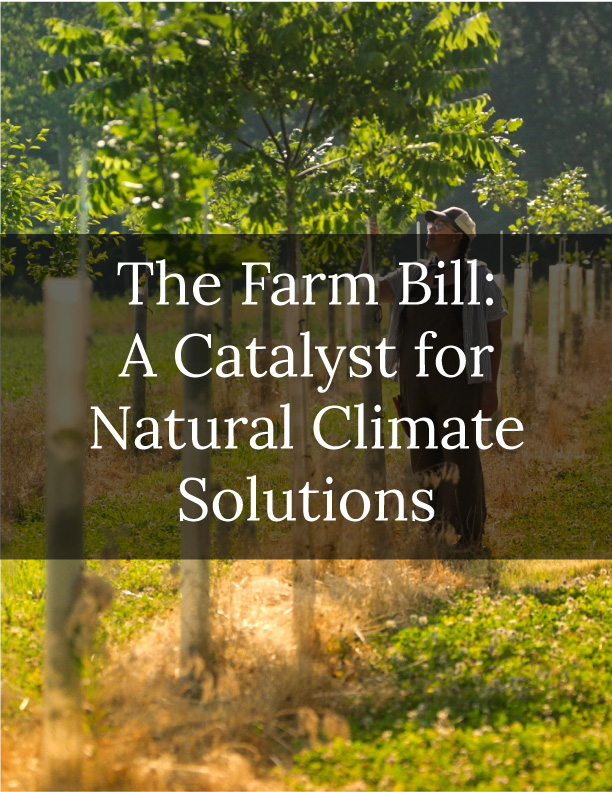As climate change intensifies weather events like storms, droughts, and heat waves, it can feel like humans are fighting a battle against nature. However, nature is one of the most effective tools in the fight against climate change. U.S. Nature4Climate (USN4C), a coalition of over 20 environmental groups, works to advance natural climate solutions, which it defines as “strategies for addressing climate change that also help restore wildlife habitat, improve water quality, increase the productivity of our farms, create jobs, and protect our communities from storms and floods.” And as USN4C’s recent polling has shown, with support from 92% of voters, natural climate solutions would be a great fit for strong bipartisan climate action.
Nature at Work
Natural climate solutions are land- and water-based actions that can combat and mitigate climate threats while incorporating resilience into both our ecosystems and economies. When executed successfully, they conserve and regenerate forests, wetlands, grasslands, agricultural fields, and other key landscapes. Such solutions range from practicing crop rotation and creating living shorelines to reforestation and restoring natural habitats through conservation efforts.
Blue-carbon ecosystems are an example of how natural climate solutions can pay dividends. Blue-carbon ecosystems include mangrove forests, seagrass meadows, and tidal marshes. These ecosystems store carbon and prevent it from being released into the atmosphere, while also mitigating flooding and soil erosion. Mangrove forests can store up to four times as much carbon as other tropical forests, protect communities from storm surges, and provide safe habitat for marine life, thus supporting nature-based industries such as fishing.
In agriculture, the practice of no-till farming can help maintain soil health and longevity. Reducing tillage intensity can improve water quality, prevent soil erosion, and potentially reduce the release of carbon dioxide from the soil. It also saves on the fuel and labor that would have otherwise been used in the tilling process. (Scientists are still working to reach a consensus on the extent of the climate-specific benefits of no-till farming.)
Natural climate solutions like these could reduce national emissions by one-fifth—especially if implemented into federal, state, and local policymaking. Such emission reductions would help the United States reach the target established by the Biden-Harris Administration of slashing greenhouse gas emissions 50% below 2005 levels by 2030 and achieving net-zero emissions by 2050.
Positive Public Perception
USN4C sought to determine how public support for natural climate solutions stacks up across the country. Results from its 2023 survey depict that an overwhelming 92% of people polled in the United States support natural climate solutions.
The survey results show that the idea of protecting natural areas for future generations has strong support across the partisan divide. Supporting wildlife habitat, water quality, and forest health also resonate highly.
Of all respondents polled, 95% of Democrats, 95% of Independents, and 86% of Republicans support natural climate solutions. And of those who responded that they do not believe in climate change, 75% still expressed support for natural climate solutions. This support demonstrates a welcome opportunity to implement these solutions around the nation.
When broken down by geographical region, the survey results offer useful takeaways for policymakers. Eighty-nine percent of respondents in rural areas support natural climate solutions, indicating the importance of researching and implementing climate solutions that benefit agriculture. Natural climate solutions that are well-suited for the agricultural sector include agroforestry, cover crops, and reduced tillage. The United States Department of Agriculture (USDA) already has programs like the Conservation Reserve Program and the Environmental Quality Incentives Program that support farmers in implementing agricultural practices that sequester carbon, but these programs are consistently oversubscribed.
The summary of the survey results discusses the importance of promoting the co-benefits of natural climate solutions—such as increased farm productivity and resilience to extreme weather events—to would-be supporters, to ensure continued support.
Pathways to Federal Prioritization
In September 2023, U.S. Nature4Climate hosted a New York Climate Week event titled “U.S. Government Support for Natural Climate Solutions Implementation.” The event, moderated by EESI President Daniel Bresette, aimed to thoroughly examine the federal actions being taken to scale up natural climate solutions. The event’s speakers included representatives from the Environmental Defense Fund, the White House, USDA, the Federation of Southern Cooperatives, and the Intertribal Agriculture Council. Panelists provided an in-depth look at how the government can effectively mobilize funding for natural climate solutions to maximize ecological and climate benefits. They touched on key agricultural programs supporting climate solutions, the White House’s 2022 roadmap for accelerating nature-based solutions, the importance of minimizing risk for agricultural producers, and the barriers to and opportunities for Indigenous communities in their pursuit of climate-smart actions.
The White House’s roadmap includes five recommendations for advancing nature-based solutions: updating policies to improve their ease of use, ensuring funding is catalyzed effectively, expanding agency action, developing the necessary workforce, and prioritizing research and learning. The event panelists discussed how the Inflation Reduction Act (IRA) (P.L. 117-169), the Infrastructure Investment and Jobs Act (IIJA) (P.L. 117-58) and the next iteration of the Farm Bill all complement these efforts and provide additional opportunities for the federal government to implement natural climate solutions and climate-smart agriculture. The IRA, for example, includes funding for natural infrastructure in underserved communities, vegetation management projects, and climate resilience in disadvantaged communities—all of which can be mobilized for nature-based solutions.
Intentional Implementation
While the potential for progress on natural climate solutions is exciting, there are several important factors that policymakers must keep in mind regarding implementation, starting with financing requirements. Project funding is often dependent on meeting specific “return on investment” targets, which can be difficult without universal standards for project monitoring, and when objectives such as biodiversity are difficult to measure. Another important factor is community buy-in. By building partnerships across the project region and ensuring community engagement from the early stages, projects are more likely to reflect local needs and allow residents to have a voice.
Woodwell Climate Research Center’s guiding principles for effective natural climate solutions emphasize the importance of Indigenous and local community participation, “doing no harm” to the people involved, fully accounting for carbon stocks, and using high standards for any carbon markets that may be used to finance natural climate solutions. These solutions should lift up the leadership of Indigenous communities and support the well-being of people and ecosystems, rather than protecting profits and the “business as usual” status quo.
Natural climate solutions are an important piece of the puzzle in addressing the climate crisis, but they are not the only piece. These solutions must be implemented thoughtfully, equitably, and holistically, and paired with swift cuts to emissions, in order to reach their full potential.
This article was originally published on the Environmental and Energy Study Institute’s website.
Additional Resources

Explore our Decision-Makers Guide to Natural Climate Solutions to better understand the science behind these strategies and get tools to implement them.


